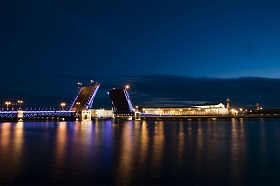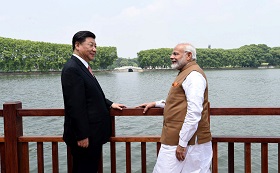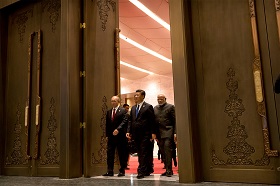While Russia’s vision of a Greater Eurasia has proven useful in addressing certain foreign policy dilemmas, it is still in need of further conceptual development. The paradigm of “orders within orders” could expand and complement the idea of a Greater Eurasian partnership, while also advancing and securing Russia’s long-term interests by reformulating its relations with the EU and China in key ways.
As Moscow’s relations with Western capitals gradually frayed over the course of the post-Cold War period, the Eurasian vector in Russian foreign policy has increased in importance, rising to the point where it now supplies one of the guiding paradigms of the country’s international vision — the Greater Eurasian partnership. Born in the post-Maidan environment, this concept has helped provide additional — albeit still limited — substance to Russia’s vision of a more pluralistic and polycentric world, transforming the world’s normative landscape and potentially reconfiguring the global geopolitical chessboard.
However, the idea of Greater Eurasia was born out of — and continues to be rooted in — contradictory impulses. These should encourage the Russian elite not to revisit the paradigm in its entirety, but rather to rethink its conceptual foundations so as to alter how it expresses itself in the real world, with the aim of strengthening the multi-vectored nature of Russia’s foreign policy.
Whether the Russian elite chose to make this new paradigm explicit or merely use it as an implicit conceptual guide, it can complement the foreign policy community’s mental map in important ways. The community is often accused of being reactive, putting forward an abstract idea of an integrated Greater Eurasian space to stall for time in the face of a rising China, even as they claim that Russia had no choice but to react forcefully regarding Ukraine in response to Washington and Brussels’ continued refusal to acknowledge the legitimacy of its interests. An attempt to infuse the Greater Eurasia vision with additional content will not only help Moscow to engage with other major powers more on its own terms, but also ensure that Russia can maximize its impact on the future shape of world order by consolidating existing normative frameworks and increasing the number of its dialogue partners.
Moreover, for a country charting a new strategy and identity at the northern tip of Eurasia following a quarter-century of frustrating attempts to find a place for itself in Europe, working to erect multiple complementary Eurasian orders would help integrate Russia’s various regions into their respective adjacent neighborhoods across the supercontinent. This would help to secure both the foundations of Russia’s multi-vectored foreign policy and its capacity to influence dynamics in multiple theatres, both of which are key to maintaining great power status over the long term.
While Russia’s vision of a Greater Eurasia has proven useful in addressing certain foreign policy dilemmas, it is still in need of further conceptual development. The paradigm of “orders within orders” could expand and complement the idea of a Greater Eurasian partnership, while also advancing and securing Russia’s long-term interests by reformulating its relations with the EU and China in key ways.
Introduction
As Moscow’s relations with Western capitals gradually frayed over the course of the post-Cold War period, the Eurasian vector in Russian foreign policy has increased in importance, rising to the point where it now supplies one of the guiding paradigms of the country’s international vision — the Greater Eurasian partnership. Born in the post-Maidan environment, this concept has helped provide additional — albeit still limited — substance to Russia’s vision of a more pluralistic and polycentric world, transforming the world’s normative landscape and potentially reconfiguring the global geopolitical chessboard.
However, the idea of Greater Eurasia was born out of — and continues to be rooted in — contradictory impulses. These should encourage the Russian elite not to revisit the paradigm in its entirety, but rather to rethink its conceptual foundations so as to alter how it expresses itself in the real world, with the aim of strengthening the multi-vectored nature of Russia’s foreign policy.
Moscow’s dilemma
On the one hand, Moscow’s “Pivot to the East” was designed, in part, to buttress the foundations of Russia’s independent great power status and strengthen the Kremlin’s hand toward Europe by deepening ties with dynamic Asian markets. The launch of this “pivot” predates the onset of the Ukraine crisis and was thus built for a world in which Russia’s ties with the EU were troubled but not overwhelmingly hostile. On the other hand, Russia’s failure in 2013 to convince Ukraine to join the Eurasian Economic Union (EAEU) not only resulted in a full-blown crisis of relations with the West, but also implied that Moscow would have to look beyond the post-Soviet space to secure a long-term place for itself in the global top tier.
Some analysts contend that EU-Russia relations will naturally improve over the long term. Nonetheless, in the meantime, Moscow finds itself situated between a European Union whose sanctions against Russia are one of the few signs of unity among member states, and a strategic partnership with China that rests on mixed foundations.
The Kremlin is keen to play up its agreement with Beijing on normative issues, such as their shared skepticism toward regime change and their commitment to the principle of non-interference in states’ internal affairs. However, this is often a case of Moscow using China instrumentally as a power multiplier in its normative dispute with the West, even though there does exist a genuine commitment to constructing a Eurasian order based on shared principles. But Russia’s Chinese dilemma runs deeper than this.
As long as relations with the West remain in the doldrums, Moscow has no choice but to make its strategic partnership with Beijing the lynchpin of its plans to maintain great power status. Russia is but a secondary actor in Asia’s regional order, which casts significant doubt on the ability of the EAEU minus Ukraine to become major pole at the global level on its own. But at the same time, failure to mend ties with the West will result in growing dependence on China, thus undermining the very aim that Russia seeks to achieve — preserving its status as an independent great power.
Reimagining great power status
Those adopting a critical view contend that the Kremlin’s great power discourse largely serves a psychological and political purpose, compensating for the loss of the Soviet Union and helping to legitimate the regime’s hold on power. This ignores the fact that it is also an eminently reasonable strategic aim: It makes sense for a declining power to attempt to secure a position at the table, where it will be able to play a role in writing the rules of the game. The question is how best to maximize Russia’s chances of earning a long-term spot at that table, and how to do so in a way that will enhance Moscow’s ability to shape the international order to reflect its interests. Great power status is a means to an end, not an end in itself.
In preparation for the return of Hong Kong to Chinese sovereignty, the Communist leadership in Beijing advanced the concept of “one country, two systems”. The aim was to solve two problems simultaneously, developing a workable model for Hong Kong while also suggesting a template for Taiwan’s eventual reunification with the mainland. Similarly, a conceptual innovation within the Greater Eurasia paradigm could help Russia to kill two birds with one stone as well, shifting the terms of its relationship with Europe while reframing the role of Central Asia in the context of the Sino-Russian partnership. We can call this concept “orders within orders.”
Visions for a Greater Eurasian partnership were framed in response to frustrations resulting from the failure of the EU and Russia to construct a single Greater European space from Lisbon to Vladivostok. As such, the tone it sets vis-à-vis Europe is largely defensive and rejectionist: Brussels cannot continue to treat Russia as a junior partner expected to conform to the EU acquis; rather, Russia must be viewed as an equal, and the EU is only welcome to join the Greater Eurasian community if it accepts its pluralistic principles. To a great extent, the result is a seeming binary rivalry between the Sino-Russian Heartland and the American-allied Rimland, limiting the benefits for many players that could flow from greater strategic promiscuity.
The paradigm of “orders within orders”, by contrast, would conceptualize EU-Russia relations as forming a regional international order within the broader Greater Eurasian order, operating according to its own principles and initiating its own separate bilateral dialogue on global ordering practices. This is very much consistent with Russia’s desire for a pluralistic Eurasia — indeed, it would even enhance Eurasia’s pluralism and deepen our understanding of its substance. What is more, it would also help to imbue ties between Brussels and Moscow with a more positive language and inclusive dynamic, while strengthening the place of the Eurasian supercontinent on the global chessboard.
Russia would thus be able to benefit from engaging in order-generating dialogue with both China and the EU without compromising on its strategic partnership with Beijing, in the process emphasizing its centrality in international affairs, enhancing the chances of it securing a long-term place at the great power table, and demonstrating that its contribution to shaping the future of international order goes beyond mere creative destruction, as critics often contend. Moscow’s current rivalry with the West and its deepening ties with China have placed it at the epicenter of several — now interconnected — flashpoints where great power interests clash, ranging from Ukraine to Syria to North Korea. Russia is therefore uniquely placed to transform the international climate and reap disproportionate benefits.
Transforming Russia’s key relationships
Some scholars have begun to suggest that the future of global politics will be determined by interactions not between powers but blocs, resulting in multiple overlapping international orders. The EU itself is a sub-regional order within Europe. Its decision-making processes, as well as the limits imposed by its institutional structure on its conduct of foreign policy, are becoming increasingly apparent. A key debate going forward will concern how it chooses to deploy its power as it consolidates its hegemonic position on the European Peninsula. Russia should seek to influence this process constructively, in order to guide it in a direction that reflects its long-term interests and entrench a logic of positive-sum cooperation in relations between Brussels and Moscow.
The current stalemate between the EU and Russia is partly the result of both sides refusing to revisit key principles underpinning the conduct of their foreign policies. Brussels will never acquiesce to a Yalta-style European order featuring spheres of influence, citing the Paris Charter’s provision that all European countries should have the right to choose their orientation. Moscow, for its part, believes that unilateral concessions on its part throughout the post-Cold War period were not reciprocated by the EU, which chose to embark on a project of constructing a Brussels-centric European order that relegated Russia to second-tier status.
To be successful, then, the paradigm of “orders within orders” needs to be billed not as a return to unilateral concessions, but rather as a reframing of the Greater Eurasian partnership designed to maximize the number of partners with which Russia can develop constructive relations. The EU could reciprocate by reinterpreting its signal concept of “resilience” that features so prominently in its 2016 Global Strategy, altering its focus from emphasizing the endurance of EU institutions and the broader liberal international order to stressing the elements of continued stability and cooperation across the wider European space (including Russia).
The paradigm could also help to delineate the contours of Moscow’s relationship with Beijing in Central Asia. Although the narrative that Russia fears losing its Central Asian sphere of influence to a rising China is often overblown, considering the region as representing a separate order within Greater Eurasia could help Moscow to entrench a certain set of principles and practices that ensure the preservation of cooperation and trust between all parties, even as geopolitical configurations and the balance of power evolve across the Eurasian supercontinent over the coming years and decades.
Whether the Russian elite chose to make this new paradigm explicit or merely use it as an implicit conceptual guide, it can complement the foreign policy community’s mental map in important ways. The community is often accused of being reactive, putting forward an abstract idea of an integrated Greater Eurasian space to stall for time in the face of a rising China, even as they claim that Russia had no choice but to react forcefully regarding Ukraine in response to Washington and Brussels’ continued refusal to acknowledge the legitimacy of its interests. An attempt to infuse the Greater Eurasia vision with additional content will not only help Moscow to engage with other major powers more on its own terms, but also ensure that Russia can maximize its impact on the future shape of world order by consolidating existing normative frameworks and increasing the number of its dialogue partners.
Moreover, for a country charting a new strategy and identity at the northern tip of Eurasia following a quarter-century of frustrating attempts to find a place for itself in Europe, working to erect multiple complementary Eurasian orders would help integrate Russia’s various regions into their respective adjacent neighborhoods across the supercontinent. This would help to secure both the foundations of Russia’s multi-vectored foreign policy and its capacity to influence dynamics in multiple theatres, both of which are key to maintaining great power status over the long term.









